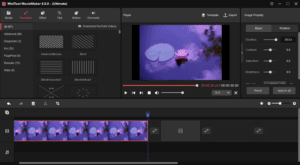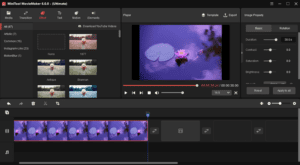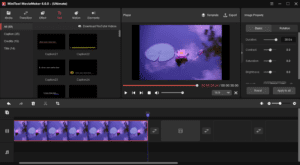Do you need to edit many movies but have very little time to do so? If so, invest in some video editing software. Wondering what should you choose? Well you are in the right place.
In this article, I will discuss a few of the most popular options, from which you may select the one that best suits your needs. Video editing software has become widely used as of late. If you want your business or product to be seen worldwide, you must have this knowledge. Several professionals find this to be an invaluable resource.
How Many Distinct Categories Does Video Editing Software Have?
One of the most significant benefits of video editing software is that it enables you to manage and edit your movies efficiently. You may improve the overall quality of your videos by utilizing video editing software to make some basic alterations to the footage. Moreover, software for video editing is widely available and can be purchased at various price points, making it feasible for anybody to edit their films. There is a plethora of software for editing videos, and each of them has its own advantages.
Many different video editing tools are available; each offers a unique combination of functionality and user-friendliness that will appeal to a specific audience. In addition, although high-quality video editing software may be expensive, it is typically well worth the investment due to its many advantages.
Video Editing vs. Video Production?

The distinction between video editing and video production mainly lies in the post-production labor of arranging the material shot. However, as more people dabble in videography, professionals and amateurs often interchange the phrases editing, production, post-production, and pre-production.
Why Is Video Editing So Important?
- Greater Professional Prospects Become Available to You
Video editing experience is widely sought in the creative sector’s employment market. This is because being able to edit videos is a versatile talent. The ability to edit videos will open up many doors for you professionally, giving you greater job security and stability.
- The Ability to Do Such Is Easily Acquired
Learning how to edit videos is not as challenging as you would think. In reality, you can be fully operational quickly if you have access to the correct courses and materials. Online video editing services make it easy to do everything from simple trimming to creating polished montages.
- There Are Many Viewerships for Videos.
Video is now the most-viewed online content and can be viewed on any device, including TVs, computers, tablets, and smartphones. Our shared appreciation for moving pictures, whether in movies, television shows, YouTube videos, Instagram Stories, or WhatsApp forwards, binds us together in this age of technology.
- Videos Are Now and In The Future’s Content
These days, most people would rather watch a short video than put in the time and effort required to read an article or blog post. So, relax and have fun because video editing are created to serve these purpose.

Video Terminology
- Frame rates: motion is created by taking still pictures or frames per second. Shooting at 24 fps gives your video a film-like quality. More than 60 fps produces smoother and more accurate slow-motion footage.
- Video resolution—the number of pixels in each frame—impacts the number of details in your video. Video resolutions include 720 (1280 x 720 pixels), 1080 (1920 x 1080 pixels), 2K (2560 x 1440 pixels), 4K (3840 x 2160 pixels), and 8K (3840 x 2160 pixels) (7680 x 4320 pixels).
- Aspect ratio: An image’s or screen’s width-to-height ratio. 4:3, 16:9, and 2:35:1 are typical aspect ratios. Video codecs compress and decompress big video files for storage and transmission. Video codecs include H.264, MPEG, and ProRes.
- File formats: These are the containers and codecs used to produce them. The container “wraps” audio and video data in a single file (with extensions like.mov,.avi, or.mp3), whereas the codec contains data.
- Safe zone: If your video may be seen on a consumer television instead of a computer or mobile device, ensure that your titles and actions fit nicely in the safe zone (safe title and safe action areas).
Sound Terminology
- Stereo vs. mono: mono is single-source audio (single-channel recording). Two independent channels are routed to the left, and proper output channels and speakers are stereos.
- Decibels measure audio level. Sample rates and bit depth determine the number of audio samples per second, resolution, and dynamic range. Production and mixdown settings use 24 bits and 48 kHz for video.
Color Terminology
- White balance: how warm or chilly your image’s hues are (basically, when white is not white).
- Color grading: This involves changing an image’s colors. It comprises contrast, sharpness, blankness, depth, white balance, color overlays, and saturation.
- Color correction: making the film seem natural by correcting color errors (repairing the original color to make it look clean and accurate).
- Waveforms and vectorscopes: This properly represents color and brightness values. Waveform and vectorscope monitors can help you produce a consistent, high-quality video product across devices, as you can’t judge video quality by how it looks on one screen.
Terminology for video editing
- Montages: A series of shots to demonstrate a topic. The video editor should offer more visual information while taking up less screen area and holding the audience’s attention.
- Transitions: A link shot in post-production. The most common transitions are cuts, dissolves, and fades (fade-out or fade-in, mainly used to show the passage of time). The cut is used 95% of the time in video editing software. Nonetheless, a well-placed transition may add a stylish visual element to the production.
- VFX: This may enhance a scene by adding or eliminating components. You may construct realistic scenes by combining live-action footage with produced pictures. Spaceships and CGI explosions are visual effects.
- Motion graphics: These are purposely animated visual components on the screen. Stylized clips, bottom-third text animations, sophisticated title sequences, and even 3D compositions may be created via a video editor. Motion graphics animations may be made with Adobe After Effects.
Three Stages Of Video Editing



Whatever the purpose of the video (music video, marketing campaign video, corporate video, etc.), three steps must be taken to ensure success:
- Pre-production
- Production
- Post-production
Editing is the main component of post-production. Nevertheless, why is it crucial to edit videos? I won’t try to convince you that video editing is the most crucial skill you can have. Without it, I can assure you, you will have a disaster on your hands. Indeed, everyone involved in making a video contributes significantly. You can’t get a decent photo if your cameraman isn’t doing his job. Without a competent director, your scenes will be chaotic and challenging. Without an editor, the other parts of your video production can’t combine to become the masterpiece you envisioned.
Choosing The Right Video Editing Software?
Choosing the appropriate video editing software is crucial since you will rely heavily on its functions and built-in capabilities. Many programs and devices are available for altering videos. So, which one to pick? What you need from your video editor is entirely up to you. Here are some things to think about while picking out video editing software:
- The fundamental and complex capabilities
- The simplicity and efficiency of its shortcuts, timeline, and user interface
- The collection of cuts, effects, and music
- Preview and export choices
- Price (free, paid) (free, paid)
If you’re starting, you need something easier to use and understand. The use of free, web-based video editing tools is an excellent place to begin. They often come equipped with everything you need to make high-quality films, such as an intuitive interface, audio, and sound effects, file input choices, animation transitions, video trimmers, preview, and export functions, etc.
MiniTool MovieMaker 6.0 is excellent choice. This software is famous for its robust editing tools and ability to handle complex jobs. MiniTool MovieMaker 6.0 is an attractive option for most people
Conclusion
The art of video editing lies in the seamless integration of visuals and audio; this transports us to another world and makes us feel part of the story we’re seeing. Video editing is one of the most crucial positions in the film business. Choosing the appropriate video editor is as crucial as picking out the correct camera gear to craft an emotionally stirring masterpiece from your film’s raw footage.
FAQs
The value of video editing is explained. When should you get an editor’s help?
The video editing industry has evolved into a niche field that has far-reaching consequences. Professional editing services should be used to improve the quality of a video after it has been made. As a first step, a skilled video editor must watch all the clips while listening to the audio.
In what time frame may a video be edited?
Unlike the typical questions, this one has a variable response. Several technological aspects and the expertise of the video editor you choose will determine the outcome. Video editing may take a few hours in some circumstances. Process some files, and it may take up to a week.
What is the definition of a video capture card?
A video capture card enables the ability to record video from a device and save it to a hard drive. The resolution also determines the overall video quality. Connecting this device to a computer is possible via USB or PCI Express.
